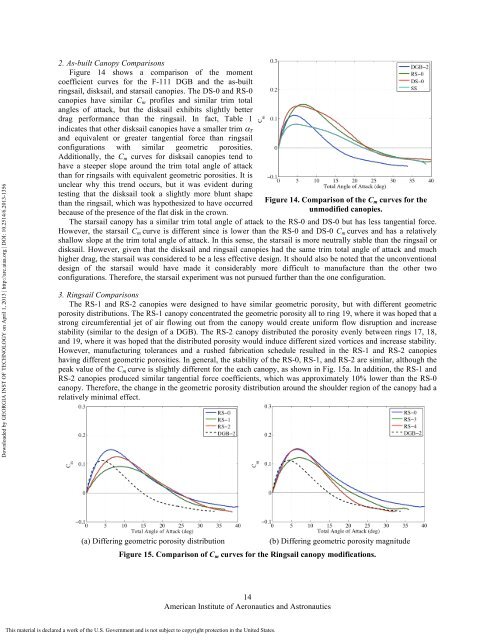Aerodynamic Stability and Performance of Next-Generation ...
Aerodynamic Stability and Performance of Next-Generation ...
Aerodynamic Stability and Performance of Next-Generation ...
You also want an ePaper? Increase the reach of your titles
YUMPU automatically turns print PDFs into web optimized ePapers that Google loves.
Downloaded by GEORGIA INST OF TECHNOLOGY on April 1, 2013 | http://arc.aiaa.org | DOI: 10.2514/6.2013-1356<br />
2. As-built Canopy Comparisons<br />
Figure 14 shows a comparison <strong>of</strong> the moment<br />
coefficient curves for the F-111 DGB <strong>and</strong> the as-built<br />
ringsail, disksail, <strong>and</strong> starsail canopies. The DS-0 <strong>and</strong> RS-0<br />
canopies have similar C m pr<strong>of</strong>iles <strong>and</strong> similar trim total<br />
angles <strong>of</strong> attack, but the disksail exhibits slightly better<br />
drag performance than the ringsail. In fact, Table 1<br />
indicates that other disksail canopies have a smaller trim α T<br />
<strong>and</strong> equivalent or greater tangential force than ringsail<br />
configurations with similar geometric porosities.<br />
Additionally, the C m curves for disksail canopies tend to<br />
have a steeper slope around the trim total angle <strong>of</strong> attack<br />
than for ringsails with equivalent geometric porosities. It is<br />
unclear why this trend occurs, but it was evident during<br />
testing that the disksail took a slightly more blunt shape<br />
than the ringsail, which was hypothesized to have occurred<br />
because <strong>of</strong> the presence <strong>of</strong> the flat disk in the crown.<br />
Figure 14. Comparison <strong>of</strong> the C m curves for the<br />
unmodified canopies.<br />
The starsail canopy has a similar trim total angle <strong>of</strong> attack to the RS-0 <strong>and</strong> DS-0 but has less tangential force.<br />
However, the starsail C m curve is different since is lower than the RS-0 <strong>and</strong> DS-0 C m curves <strong>and</strong> has a relatively<br />
shallow slope at the trim total angle <strong>of</strong> attack. In this sense, the starsail is more neutrally stable than the ringsail or<br />
disksail. However, given that the disksail <strong>and</strong> ringsail canopies had the same trim total angle <strong>of</strong> attack <strong>and</strong> much<br />
higher drag, the starsail was considered to be a less effective design. It should also be noted that the unconventional<br />
design <strong>of</strong> the starsail would have made it considerably more difficult to manufacture than the other two<br />
configurations. Therefore, the starsail experiment was not pursued further than the one configuration.<br />
3. Ringsail Comparisons<br />
The RS-1 <strong>and</strong> RS-2 canopies were designed to have similar geometric porosity, but with different geometric<br />
porosity distributions. The RS-1 canopy concentrated the geometric porosity all to ring 19, where it was hoped that a<br />
strong circumferential jet <strong>of</strong> air flowing out from the canopy would create uniform flow disruption <strong>and</strong> increase<br />
stability (similar to the design <strong>of</strong> a DGB). The RS-2 canopy distributed the porosity evenly between rings 17, 18,<br />
<strong>and</strong> 19, where it was hoped that the distributed porosity would induce different sized vortices <strong>and</strong> increase stability.<br />
However, manufacturing tolerances <strong>and</strong> a rushed fabrication schedule resulted in the RS-1 <strong>and</strong> RS-2 canopies<br />
having different geometric porosities. In general, the stability <strong>of</strong> the RS-0, RS-1, <strong>and</strong> RS-2 are similar, although the<br />
peak value <strong>of</strong> the C m curve is slightly different for the each canopy, as shown in Fig. 15a. In addition, the RS-1 <strong>and</strong><br />
RS-2 canopies produced similar tangential force coefficients, which was approximately 10% lower than the RS-0<br />
canopy. Therefore, the change in the geometric porosity distribution around the shoulder region <strong>of</strong> the canopy had a<br />
relatively minimal effect.<br />
(a) Differing geometric porosity distribution<br />
(b) Differing geometric porosity magnitude<br />
Figure 15. Comparison <strong>of</strong> C m curves for the Ringsail canopy modifications.<br />
14<br />
American Institute <strong>of</strong> Aeronautics <strong>and</strong> Astronautics<br />
This material is declared a work <strong>of</strong> the U.S. Government <strong>and</strong> is not subject to copyright protection in the United States.
















